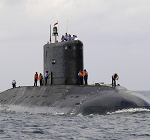The accident onboard the INS Sindhuratna on February 26, off the coast of Mumbai, could not have come at a worse time for the Indian Navy, already grappling with the recent spate of accidents. Taking moral responsibility, the Chief of Naval Staff, Admiral D. K. Joshi, has now resigned. It is a symbolic gesture for a military officer concerned with his honour and dignity, and that of his forces. But his resignation, and official inquiries, are unlikely to fix the chronic problems that afflict our naval fleet and its operational readiness.
First, the more recent accidents – the fire on board the INS Sindhuratna and the sinking of the INS Sindhurakhsak last year – have highlighted the Indian Navy’s deficient and ageing submarine fleet. No new submarines have been acquired since the year 2000 except the INS Chakra, a nuclear submarine bought on a 10-year lease from Russia in 2012.
Given the long gestation periods associated with any big-ticket defence acquisition, our decision makers – the political leadership and the Ministry of Defence bureaucracy – need to expedite the pending proposals for the purchase of naval multi-role helicopters, amphibious aircrafts, and warships for augmenting our naval capabilities to deal with the challenges of the growing Chinese naval presence in the Indian Ocean region, piracy, protecting our expanding economic interests and carrying out humanitarian assistance and disaster relief operations.
These acquisitions also include a long-overdue, inexcusably-delayed purchase of the Scorpène-class submarines from the French manufacturer DCNS, which will add a submarine fleet equipped with air-independent propulsion technology (allowing the vessel to remain submerged for a longer time).
Second, the corruption in our defence purchases over the last 10 years and the blacklisting of large corporations like AgustaWestland and Israel Military Industry, which were also implicated, means that there are almost no global defence firms India can do business with. To overcome this, it is essential to streamline and clean up the acquisition process. For immediate impact, existing deals with foreign defence manufacturers like DCNS must be pursued to their logical conclusion to maintain India’s international credibility.
We must also build capacity at home to reduce our over-reliance on Russian and other external military hardware. The angst generated by the latest accident can be used to push for scaling up the abilities of indigenous ship and equipment manufacturers. New Delhi has emaciated the army and air force by developing foreign dependencies in key weapons platforms. This is also linked to the middlemen, who for so long have been the bane of India’s defence acquisition process.
The navy should not meet such a fate, particularly when it has been the most indigenised in its expansion, through the induction of Shivalik class stealth frigates and submarine-launched Sagarika ballistic missile. Clear steps like allowing a greater role for the armed forces, and introducing a parliamentary committee with multi-party representation to keep a check on the executive branch’s decision-making, must be taken to end the role of middlemen in defence purchases.
This, then, is also an opportune moment for the government to bring out a clearly-defined policy on stepping up R&D for indigenous defence production and the role of the private sector therein. We already have the stellar example of L&T shipbuilding’s involvement in the nuclear submarine project.
Third, India must revisit the practice of refitting and upgrading the naval fleet, which unfortunately has become the norm because the purchase of many key defence platforms has seen prolonged delays for a variety of technological, financial and political reasons. Ironically, even the refitting and upgrading programmes are succumbing to the same chronic delays – like the INS Vikramaditya aircraft carrier and its five-year delayed upgrade in Russia – creating doubts that corners may have been cut to make up for the delays.
Fourth, while the loss of vessels – like the Sindhurakshak – constitutes a big setback, equally critical is the loss of trained, expert naval officers and engineers. This has a bearing on our operational preparedness, specifically when the Indian armed forces are already short on officers. Upgrading the training programmes with a particular focus on safety protocols should be the priority for the navy.
The spate of accidents is particularly unfortunate for the Indian Navy now, when its role has expanded in view of India’s maritime security concerns and the country’s rising profile in the Indian Ocean region, as highlighted by Exercise ‘Milan’ two weeks ago.
Southeast Asian countries are looking at India to be a regional net security provider, especially with China’s growing maritime aggression. Many of these countries plan to acquire submarines in an effort to boost their undersea combat capability – technology and expertise that India should also be able to offer. Pertinently, China has also demonstrated the utility of amphibious platforms in combat situations through an exercise last month involving its largest amphibious ship Changbaishan, in the eastern Indian Ocean.
All this requires a seriousness on the part of New Delhi, at the moment so indifferent to matters of defence planning and operational preparedness not just towards the Indian Navy but the entire armed forces. The onus then lies on the next elected government to comprehensively review national security threats, introduce professionals in military decision-making, and examine whether the existing deployment of armed forces is giving India optimum returns.
Sameer Patil is Associate Fellow, National Security, Ethnic Conflict and Terrorism, at Gateway House.
This article was exclusively written for Gateway House: Indian Council on Global Relations. You can read more exclusive content here.
For interview requests with the author, or for permission to republish, please contact outreach@gatewayhouse.in.
© Copyright 2014 Gateway House: Indian Council on Global Relations. All rights reserved. Any unauthorized copying or reproduction is strictly prohibited


